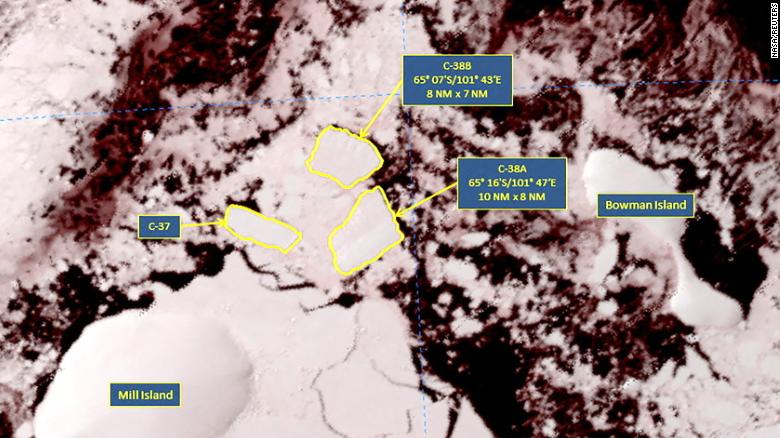Meet the radio that transmits "heat" in Antarctica 1:28
(Reuters) --
Antarctica's coastal glaciers are shedding icebergs at a faster rate than nature can replenish the crumbling ice, doubling previous estimates of losses from the world's largest ice sheet in the past few years. past 25 years, satellite analysis showed on Wednesday.
The first study of its kind, led by researchers at NASA's Jet Propulsion Laboratory (JPL) near Los Angeles and published in the academic journal Nature, raises new concerns about how quickly climate change is weakening the floating ice shelves of Antarctica and accelerates global sea level rise.
Thinning and calving have reduced the mass of Antarctica's ice shelves by 12 billion tons since 1997, according to an analysis.
The main conclusion of the study is that the net loss of Antarctic ice from calving chunks of coastal glaciers into the ocean is almost as great as the net amount of ice that scientists already knew was being lost due to thinning caused by melting. of ice shelves from below by warming seas.
There is a 50/50 chance that the world will pass the critical global warming threshold in the next five years
Together, thinning and calving have reduced the mass of Antarctica's ice shelves by 12 trillion tonnes since 1997, double the previous estimate, the analysis concluded.
NASA's Modis satellite image of an Antarctic ice shelf taken on March 21 in this distributed image.
The net loss of the continent's ice sheet from calving alone in the last quarter century covers almost 37,000 square kilometers, an area almost the size of Switzerland, according to JPL scientist Chad Greene, lead author of the study.
"Antarctica is crumbling at its edges," Greene said in a NASA announcement about the findings.
"And when ice shelves shrink and weaken, the continent's huge glaciers tend to accelerate and increase the rate of global sea level rise."
advertising
The consequences could be huge.
Antarctica hosts 88% of the sea-level rise potential of all the world's ice, she said.
Ice shelves, permanent floating sheets of frozen freshwater attached to the land, take thousands of years to form and act as buttresses holding back glaciers that would otherwise slide easily into the ocean, causing the sea to rise.
When ice shelves are stable, the natural long-term cycle of calving and regrowth keeps their size fairly constant.
However, in recent decades, warming oceans have weakened the shelves from below, a phenomenon previously documented by satellite altimeters that measure the changing height of the ice and show losses of an average of 149 million tons per year. year between 2002 and 2020, according to NASA.
They find a huge amount of water under the Antarctic ice sheet for the first time in history
images from space
For their analysis, Greene's team synthesized satellite images of visible, thermal and infrared wavelengths, and radar to map glacial flow and calving since 1997 more accurately than ever over 50,000 kilometers of Antarctic coastline.
Measured losses from ice calving have so far outstripped the natural replenishment of the ice shelf that researchers consider it unlikely that Antarctica will be able to return to pre-2000 glacial levels by the end of this century.
Accelerated glacial calving, like ice thinning, was most pronounced in West Antarctica, an area most affected by warming ocean currents.
But even in East Antarctica, a region whose ice shelves were long considered less vulnerable, "we saw more losses than gains," Greene noted.
It is relatively common for ice shelves in Antarctica to spawn icebergs.
It is less common for an ice shelf to disintegrate completely.
In March 2022, an East Antarctic ice shelf did both.
One calving event in East Antarctica that took the world by surprise was the collapse and disintegration of the massive Conger-Glenzer ice shelf in March, possibly a sign of further weakening to come, Greene said.
Ice shelf in Antarctica collapses due to temperatures 0:48
Eric Wolff, Royal Society Research Professor at the University of Cambridge, pointed to the study's analysis of the behavior of the East Antarctic Ice Sheet during past warm periods and models of what may happen in the future. .
"The good news is that if we maintain the 2°C global warming promised by the Paris agreement, sea level rise from the East Antarctic Ice Sheet should be modest," Wolff wrote in a commentary on the study. from JPL.
However, if greenhouse gas emissions are not curbed, there is a risk that the sea level will rise many meters in the coming centuries," he said.
AntarcticaClimate changethaw

